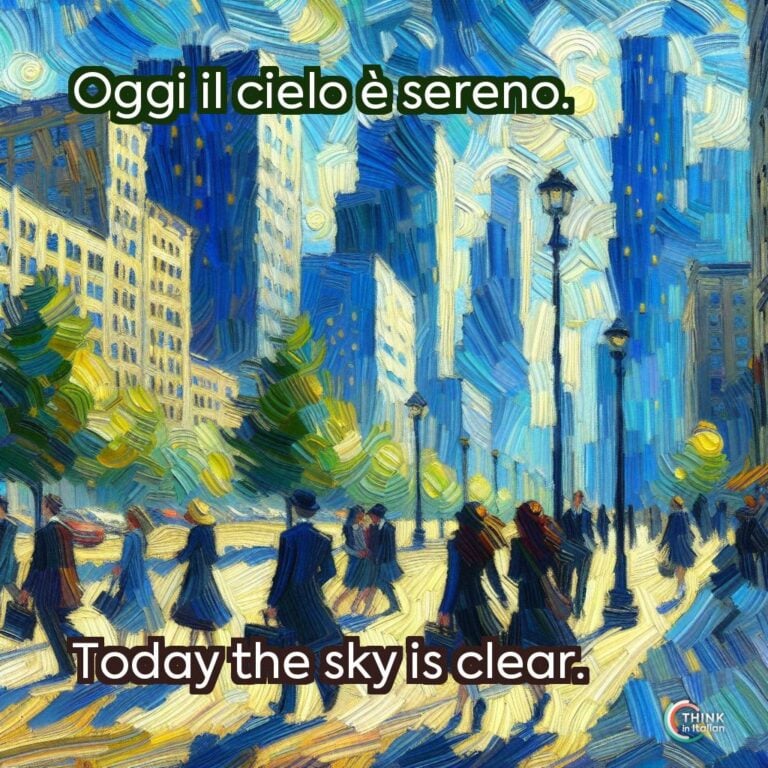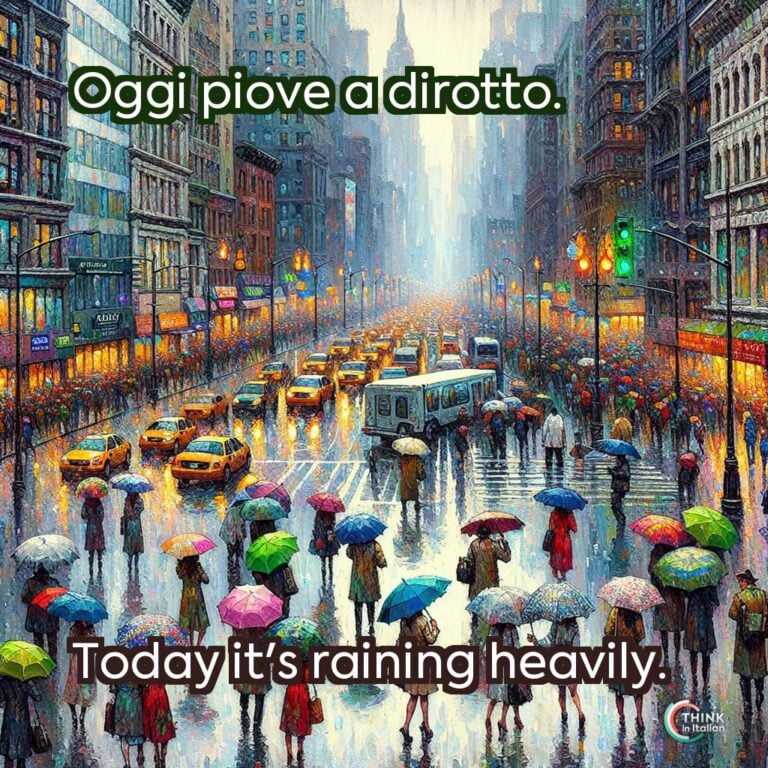Talking About the Weather in Italian
For me, as an Italian native speaker who was born and raised in Italy, discussing the weather is more than just vocabulary. It’s a rich cultural exchange that deeply influences most Italian conversations.
You might considered it small talks, and probably you are right, but in a way or another, the weather always finds its way into our conversations.
Italy is a beautiful country with diverse weather patterns, which makes it necessary to know how to talk about the weather in Italian. Also, if you want to practice some conversational skills, I believe the weather is a perfect topic to have a conversation in Italian.
Whenever I teach this class to my students, I like to divide it into four parts, and here I will do the same with you! So take a seat and learn how to say what the weather is like in Italian.
How to Talk About the Weather in Italian
Verb
The first thing I want to teach you regards specific verbs we use to express the weather. This works just like in English, where you can use a verb to say what the weather is like.
Unlike English, Italian does not have an explicit logical subject when it comes to impersonal constructions. Therefore, you will only need to conjugate these verbs in the third person singular.
- piovere (to rain)
- nevicare (to snow)
- grandinare (to hail)
Luckily, these three verbs are regular, therefore their conjugation is quite easy. Have a look at the examples below:
Che tempo orribile oggi! Piove e grandina! E ho letto che domani nevica pure!
Such a horrible weather today! It rains and hails! And I read that tomorrow it snows too!
Essere + Adjective
Another very useful way to express the weather in Italian is by describing it. And when it comes to descriptions, we have to use adjectives.
Just like I explained in the previous section, you have to conjugate the verb essere (to be) in the third person singular: è.
Here, I will give you a list of all possible adjectives you can use with this construction:
- bello (nice)
- brutto (bad)
- soleggiato (sunny)
- nuvoloso (cloudy)
- ventoso (windy)
- piovoso (rainy)
- nevoso (snowy)
- umido (humid)
- secco (dry)
- sereno (clear)
- tempestoso (stormy)
- gelido (freezing)
Com’è il tempo oggi?
How is the weather today?
Non è molto bello, è soleggiato ma è anche ventoso.
It is not very good, it is sunny but it is also windy.
The verb “Fare”
The Italian verb fare is very versatile and commonly used. When speaking about the weather, it can be used in two expressions only, but for me these two are crucial to properly express oneself.
Learn all the meanings of the verb fare in Italian.
Again, just conjugate it in the third person singular and add either caldo (hot) or freddo (cold), and you’re set!
Che tempo fa?
What’s the weather like?
Fa caldo/freddo.
It’s hot/cold.
As you might have noticed, we use fare also to ask questions!
C’è/ci Sono + Noun
The last way I want to show you to express the weather in Italian is with c’è/ci sono, which correspond to there is/there are in Italian.
When using this expression, you must add a noun, because it is used to express the existence of something. Here is a list of possible combinations:
- il sole (sun)
- la pioggia (rain)
- la neve (snow)
- il vento (wind)
- la nebbia (fog)
- la tempesta (storm)
- il temporale (thunderstorm)
- il gelo (frost)
- l’umidità (humidity)
- la grandine (hail)
- le nuvole (clouds)
- i fulmini (lightning)
Of course, remember to use the definite article and make sure the verb is conjugated in the third person singular for singular items and plural for plural ones!
For example:
C’è il sole.
There is sun.
C’è la grandine.
There is hail.
Ci sono le nuvole.
There are clouds.
Advanced Italian weather vocabulary
Now that we have covered the basics of Italian grammar let’s move on to some advanced Italian weather vocabulary. Here are some words and phrases that will help you describe the weather in more detail:
Il cielo è sereno.
The sky is clear.
La temperatura è molto alta/bassa.
The temperature is very high/low.
La brezza è fresca.
The breeze is cool.
Il vento è forte.
The wind is strong
La nebbia è fitta.
The fog is thick.
Arriva un fronte freddo.
A cold front is coming.
These vocabulary words will help you describe the weather in more detail and have more meaningful conversations with Italians.
Weather-Related Idioms and Expressions in Italian
Like any language, Italian has its fair share of weather-related idioms and expressions.
Here are a few examples:
Piove sul bagnato.
It never rains, but it pours.
Fa un freddo cane.
It’s very cold.
Avere la testa tra le nuvole.
To have your head in the clouds.
Avere il sole in tasca.
To have the world at your feet.
C’è un temporale in un bicchier d’acqua.
It’s a storm in a teacup.
These idioms and expressions are a fun way to add some spice to your Italian conversations and make you sound more fluent.






